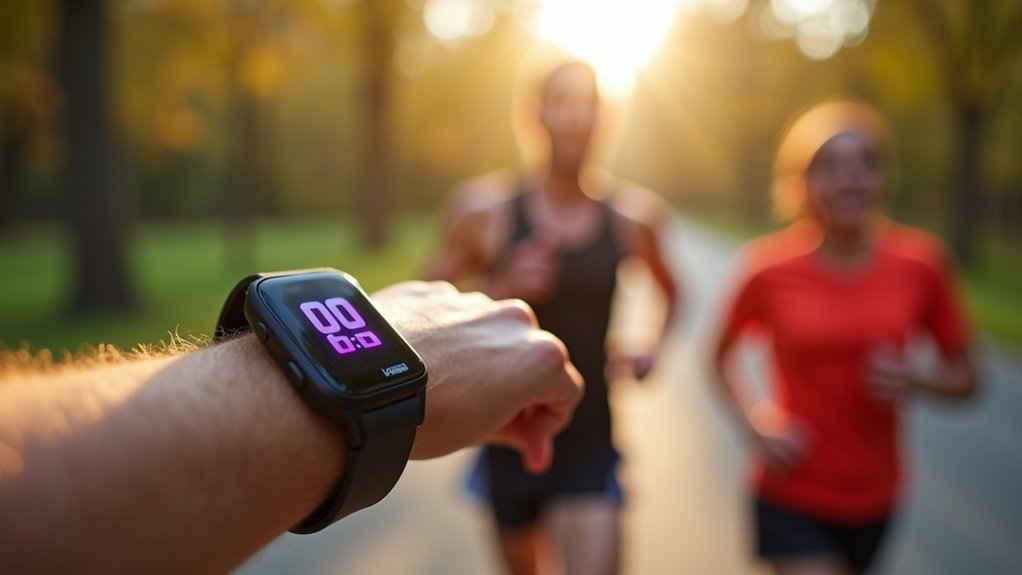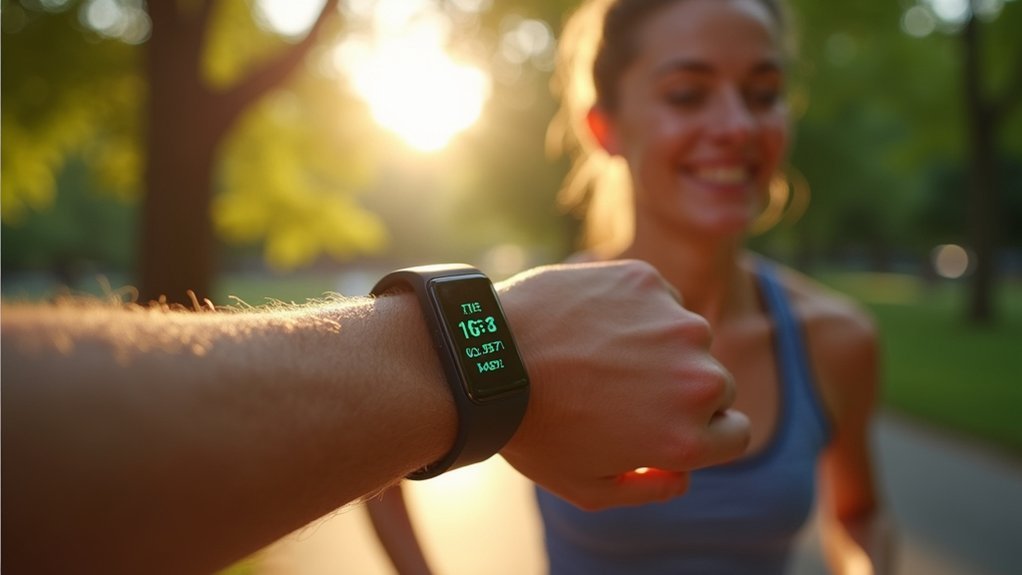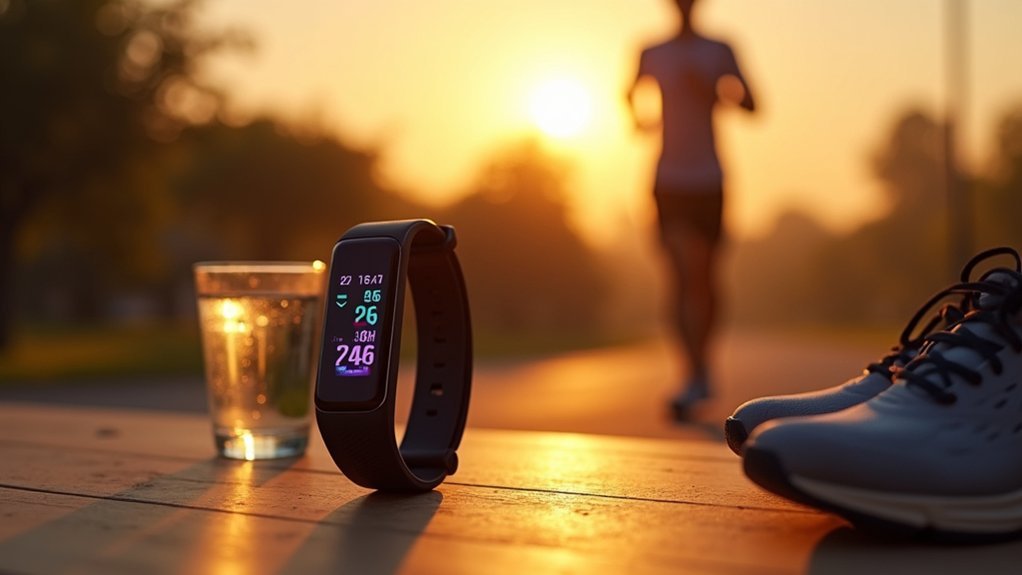Tracking body temperature with fitness wearables gives you essential insights beyond basic metrics. You’ll make smarter pacing decisions, prevent heat-related illnesses, and optimize your training based on how your body responds to exertion. Core temperature monitoring helps you identify your personal heat thresholds, adapt to different environments, and enhance recovery. With accurate temperature data, you can improve performance by up to 8% through proper heat management. The science behind these benefits reveals even more performance advantages.
The Science Behind Core Temperature Monitoring

While traditional temperature monitoring required invasive methods, today’s wearable devices offer a revolutionary approach to tracking your core body temperature.
These advanced sensors use thermal energy transfer principles between your body and the environment to calculate core temperature accurately.
The technology employs AI-powered algorithms that convert heat flux data with medical-grade precision (±0.2°C), comparable to measurements from ingested electronic pills. This innovation eliminates the need for uncomfortable rectal or esophageal probes while maintaining accuracy.
Your core temperature directly reflects metabolic heat production and serves as a critical physiological stress indicator.
The sensors measure skin temperature and heat flux simultaneously, often integrating heart rate data for enhanced accuracy during physical activity.
This combination of biometric inputs through calera∙gt thermal sensor technology provides continuous monitoring whether you’re active or at rest. The CORE sensor device offers IPX7 waterproofing, allowing reliable temperature monitoring even in wet conditions up to 1.5 meters depth.
How Temperature Tracking Enhances Athletic Performance
You’ll gain significant performance advantages through heat acclimatization when you monitor your core temperature during training.
Temperature tracking allows you to make strategic pacing decisions based on your body’s thermal responses, preventing premature fatigue in challenging conditions.
Technical clothing can help maintain optimal body temperature during exertion by supporting proper heat dissipation throughout high-intensity activities.
Heat Acclimatization Benefits
When athletes train consistently in hot environments, their bodies undergo remarkable physiological adaptations that enhance performance across all conditions.
Using wearables to track your temperature during heat acclimatization helps you safely achieve these benefits while preventing dangerous overheating.
- Improved cardiovascular function – Your body increases plasma volume by approximately 6.5%, enhancing oxygen delivery to muscles even in cooler conditions.
- Enhanced thermoregulation – You’ll develop earlier onset of sweating and higher sweat rates, maximizing your body’s natural cooling mechanisms.
- Better endurance capacity – Heat-acclimatized athletes experience improved VO2 max and lactate threshold, delaying fatigue during sustained exercise.
- Reduced perceived exertion – You’ll feel more comfortable during intense workouts as your body adapts to efficiently manage heat stress. Complete acclimatization typically requires 7-14 days of consistent heat exposure with proper monitoring.
Strategic Pacing Decisions
The critical edge in athletic performance often comes from knowing when to push harder and when to dial back intensity. Core temperature monitoring provides real-time data that transforms your pacing strategy from guesswork to science.
As your core temperature rises during exertion, you’ll receive immediate feedback allowing you to adjust your pace before performance declines. This prevents you from overshooting your thermal limits and hitting the wall prematurely.
Your body’s unique thermal response signature—how quickly you heat up and cool down—becomes visible through consistent tracking. This personalized insight helps you create customized pacing strategies that maximize your output while maintaining thermal balance.
You’ll learn exactly when to conserve energy and when you can safely accelerate, optimizing power output throughout your race or training session. Studies have demonstrated that proper heat management can lead to approximately 8% speed improvement in cyclists after dedicated heat training protocols.
Preventing Heat-Related Illnesses During Exercise

Understanding your body’s response to heat can mean the difference between a productive workout and a medical emergency.
Heat-related illnesses occur most frequently during intense exercise, especially in hot, humid environments. You’ll need to take proactive steps to protect yourself. Pay attention to the heat index when planning outdoor workouts, as it measures how the temperature actually feels to your body when humidity is factored in.
- Acclimate gradually – Allow your body 10-14 days to adapt to exercising in heat by slowly increasing workout intensity.
- Hydrate strategically – Drink 17-20 ounces of water before exercise, continue hydrating during activity, and replenish fluids afterward.
- Recognize warning signs – Watch for muscle cramping, dizziness, or nausea, which require immediate action.
- Make smart choices – Wear lightweight, breathable clothing and schedule workouts for cooler times of day.
Don’t wait for symptoms to appear—prevention is your best defense against heat illness.
Optimizing Training With Real-Time Temperature Data
With real-time temperature data from wearables, you’ll find your ideal performance zones by tracking exactly when your body heats up too much and power output decreases.
You can develop strategic race pacing based on your personal heat thresholds, allowing you to maintain effort levels that won’t prematurely spike your core temperature.
Your temperature trends during different workouts will reveal your unique heat adaptation progress, enabling completely personalized training protocols that maximize the physiological benefits of controlled heat exposure. The Core sensor provides non-invasive measurement of your internal temperature, giving you accurate data without uncomfortable methods.
Optimize Performance Zones
As athletes push their physical limits during training sessions, real-time core temperature monitoring has emerged as a game-changing tool for performance enhancement.
By tracking your core temperature zones, you’ll gain precise insights into your body’s physiological responses, allowing you to train smarter, not just harder.
- Target ideal adaptation zones – Stay in your personalized “heat training zone” for 45-60 minutes, 2-3 times weekly to improve heat tolerance and endurance.
- Prevent overtraining – Adjust effort immediately based on temperature feedback to avoid excessive thermal strain.
- Personalize your approach – Account for individual variability in heat response to maximize adaptation safely.
- Enhance data integration – Sync temperature data with heart rate and pace metrics across popular platforms like Garmin, TrainingPeaks, and Intervals.icu for thorough analysis. Elite athletes including Kristian Blummenfelt and Gustav Iden have gained competitive advantages through heat training optimization with wearable temperature monitors.
Strategic Race Pacing
Temperature data extends beyond training zones into the critical domain of race day execution. By monitoring your body temperature during races, you can dynamically adjust your pace to prevent overheating and premature fatigue, especially when ambient temperatures exceed 59°F.
Research shows each 1.8°F increase above ideal range slows faster runners by 1 second per mile, while slower runners lose 4-4.5 seconds. You’ll benefit most from this data by creating adaptive pacing strategies based on temperature forecasts and real-time feedback. Elite and faster runners tend to experience less performance decline since they generate less metabolic heat during races.
Your wearable’s temperature readings can guide strategic decisions about when to conserve energy, when to push, and how to modulate hydration needs throughout different race segments.
This personalized approach helps you maintain endurance longer and minimize performance decline, particularly in variable temperature conditions.
Personalized Heat Adaptation
While traditional training methods often follow rigid guidelines, real-time body temperature monitoring has revolutionized heat adaptation for athletes of all levels. Your wearable device continuously tracks thermal strain, enabling you to make immediate adjustments to prevent heat-related illnesses.
- Instant feedback – Receive alerts when your core temperature approaches dangerous levels, allowing you to modify intensity before problems occur.
- Tailored cooling strategies – Target specific body regions experiencing temperature spikes with precision ventilation or hydration.
- Optimized recovery – Use temperature trends to determine ideal post-workout cooling methods and timing.
- Sustainable training – Balance heat exposure to trigger beneficial adaptations like increased plasma volume without risking exhaustion. Research shows that devices like Embr Wave can make users feel an average of 5°F cooler in just three minutes, providing immediate relief during intense workouts.
With personalized temperature data, you’ll stay within your thermal comfort zone while systematically improving heat tolerance through controlled, progressive exposure.
Temperature Integration With Other Fitness Metrics
Modern fitness tracking has evolved beyond isolated data points, with body temperature measurements now seamlessly integrating with other biometric readings for thorough health analysis. When paired with heart rate monitors, temperature sensors provide more accurate core readings, especially during intense activity. The CORE sensor delivers medical-grade accuracy with a Mean Absolute Deviation of only 0.21°C, ensuring athletes receive reliable data for decision-making.
| Metric Combination | Benefit | Application |
|---|---|---|
| Temperature + Heart Rate | Improved accuracy | Performance pacing |
| Temperature + GPS | Environmental context | Heat adaptation tracking |
| Temperature + Power | Efficiency analysis | Cycling performance gains |
| Temperature + HRV | Recovery indicators | Training load management |
Your wearable’s temperature data broadcasts via ANT+ and Bluetooth Smart, connecting with platforms like Garmin, Training Peaks, and Today’s Plan. This integration enables AI-powered insights tailored to your physiology, helping you identify personal heat tolerance limits and optimize recovery between training sessions.
Non-Invasive Solutions For Continuous Temperature Monitoring

Despite previous limitations in obtaining accurate body measurements outside clinical settings, today’s non-invasive temperature monitoring solutions offer remarkable precision for fitness enthusiasts and athletes.
Using zero-heat-flux technology, these devices create isothermic tunnels that accurately estimate core temperature from your skin’s surface.
- Adhesive sensor patches collect temperature data every 5 minutes and store it for later retrieval, allowing you to track subtle fluctuations without discomfort.
- Biocompatible materials prevent skin irritation during prolonged wear, with IPX5 certification ensuring resistance to sweat and environmental exposure.
- Smartphone integration translates raw data into visualized temperature trends you can easily interpret. These modern devices provide continuous temperature monitoring capabilities that were previously only available in intensive care units.
- Wireless connectivity enables remote monitoring and seamless integration with your existing digital fitness platforms.
Temperature Tracking For Recovery And Sleep Quality
As your core body temperature fluctuates throughout the day, these subtle thermal variations provide critical insights into your recovery status and sleep quality.
Continuous monitoring helps you quantify heat strain during workouts, preventing overtraining and optimizing recovery periods based on actual physiological data rather than subjective feelings.
Track your body’s true recovery needs through objective thermal data, not just how you feel.
During sleep, your core temperature naturally decreases to facilitate restful phases.
Wearables that track these patterns can detect disruptions like night sweats or fever that compromise sleep’s restorative benefits.
This data integrates with other biometrics to create a thorough view of your recovery status.
The Core body sensor offers lightweight, non-invasive measurement of internal temperature for athletes seeking comprehensive physiological data.
Frequently Asked Questions
How Accurate Are Wearable Temperature Sensors Compared to Medical Thermometers?
Wearable temperature sensors typically achieve ±0.1-0.2°C accuracy compared to medical thermometers. You’ll find the best ones show 99% correlation with clinical measurements, though factors like activity and skin contact can affect their precision.
Can Temperature Tracking Wearables Work in Extreme Weather Conditions?
Yes, temperature tracking wearables can function effectively in extreme weather. Research confirms they provide valid and reliable metrics in harsh conditions, helping you monitor physiological responses, prevent heat-related illnesses, and optimize your performance during extreme temperature exposure.
Do Temperature Sensors Drain Connected Device Batteries Faster?
Temperature sensors like Garmin Tempe have minimal impact on your device’s battery life. They’re designed to be low-power and efficient. You’ll notice other features like always-on displays drain your battery much faster than temperature monitoring.
Are Body Temperature Trackers Waterproof for Swimming Workouts?
Many body temperature trackers are waterproof for swimming, but check your device’s specific rating. IP67 handles shallow water briefly, while IP68 offers better protection. Look for silicone bands that dry quickly for maximum comfort.
Can Temperature Data Be Exported to Other Health Platforms?
Yes, you can export temperature data from most fitness wearables to other health platforms using native export features or third-party tools like FitnessSyncer. Different devices offer varying capabilities through their apps or specialized integration services.
In Summary
Body temperature tracking through your fitness wearable isn’t just another metric—it’s essential data that can transform your training. You’ll optimize performance, prevent heat-related dangers, and enhance recovery when you monitor your core temperature. By integrating this valuable information with other fitness metrics, you’re creating a thorough picture of your body’s response to exercise. It’s a small feature that delivers significant benefits to your overall fitness journey.





Leave a Reply